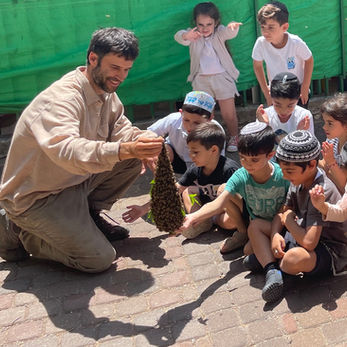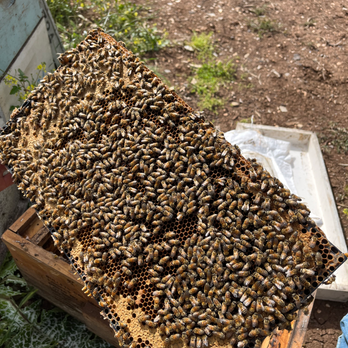
BEES
One of our projects is the bee conservation initiative for biodiversity. The project aims to address the complex factors that contribute to the decline of bee populations, such as harmful pesticides, habitat loss and parasites such as the varroa mite.
We advocate an approach that includes policy change, public education and moving to more sustainable agricultural practices. At the heart of our initiative is the idea of moving to natural and respectful methods

Our uniqueness is also related
to the fact that we do not
"keep" bees"
Instead, The swarms choose us
We do not bring swarms but provide a clean and safe environment, and in the spring, when swarms split up and look for a new place to become their home, they also choose our hives. This is how the swarms chose a hive that suits them and settled here of their own free will. Some of the swarms are sheltered from the houses of people who complained about the settlement, and before the possibility of pest control, they are brought here.

With the honey bee, a fascinating cooperation takes place in the process of building the honeycombs. The lack of an external control focus is evident in all observations. Biologists call such a social group of animals a superorganism.
Despite the physical individuality of these animals, they cooperate so closely, cohesively and integrated that they resemble a single cohesive body.
In the focus of our research are human situations in which similar phenomena appear in groups to the beehive phenomenon

Hive Mind
The bee is a solar animal associated with the movement of the earth in relation to the cosmos. In this way, plants finish their seasonal cycle and bloom, and the activity of the bees intensifies towards them. The nectar is collected and delivered to the hive not before it is transformed in their stomachs into the thick gold. In this way, the honey is stored in the hive in an amount that is sufficient to feed the new borns and the bees themselves. Their communication also depends on the rotation of the earth around itself Minute by minute the sun's position in the sky changes. In the dance, the bee tells her friends about a cluster of flowers that she discovered when the direction of the dance movements is related to the position of the sun in the sky in relation to the flower meadow. In winter the sun is less present and the blossoms weaken. The bees will regulate the reproduction rate in the hive so that fewer larvae will hatch and less honey will be eaten and the bees themselves will slow down and live longer. This regulation and abilities such as building cells that are intelligent structures with clear symmetry are not characteristics of the bee but of the entire hive


Queen Bee
The queen bee is the heart of the hive and the future of all bees. She is the mother of all the other individuals in the hive and only she lays eggs. The ability to be such a queen or heart is determined by how it grows. An ordinary egg is transferred to a large cell that has a lot of room to develop, where a larva hatches that is fed intensively with unique food, so that its purpose is determined in advance. A queen bee hatches from the egg after about 15 days, which is a shorter time than the development stage of a normal bee, and still thanks to the attention she receives and the nutrition she gets bigger in her body and has a unique role. The queen bee is the heart of the hive and the future of all bees. She is the mother of all the other individuals in the hive and only she lays eggs. The ability to be such a queen or heart is determined by how it grows. An ordinary egg is transferred to a large cell that has a lot of room to develop, where a larva hatches that is fed intensively with unique food, so that its purpose is determined in advance. A queen hatches from the egg after about 15 days, which is a shorter time than the development stage of a normal bee, and still thanks to the attention she receives and the nutrition she gets bigger in her body and has a unique role
Group Decision Making
The bees are a superorganism - a single entity that appears to be split into bees, having something in common that organizes their course of action in a masterful way. There is no single bee, there is one big one. The lone bee will die if it doesn't find its way to the hive before dark. In the sunlight they are active and are seen individually busy in action And at night from all ends they are gathered into the whole - into the beehive that will store them until the next sun show. Applications are like the skeleton in our body, The structure that carries the activity of the bees. This is the beginning of every hive - cells that only help them live as a group. That's why an injury to the sickle is very painful, like an injury to the human skeleton. The bees are a superorganism - one entity that seems split into bees, who have something in common that organizes their way of action in a masterful way. There is no single bee, there is one big one. The lone bee will die if it doesn't find its way to the hive before dark. In the sunlight they are active and are seen individually busy in action And at night from all ends they are gathered into the whole - into the beehive that will store them until the next sun show. Applications are like the skeleton in our body, The structure that carries the activity of the bees. This is the beginning of every hive - cells that only help them live as a group. That's why injury to the sick is very painful, like injury to the human skeleton


"Biological systems are a mystery.
Joint decision-making in a swarm of bees, the formation of plant colonies, the organization of organs in our body as cells and the cells into organs, are all forms of organization of components that have evolved into ecological units that function in synchronization at the level of the entire system. In analogy to systems of self-organization in nature, and in correspondence with new evolutionary, sociological and ecological theories, we study special phenomena in which people are part of a larger system, which sees individuals as parts of social organisms and provides a new perspective with many implications for improving well-being in all dimensions.
Swarms of bees are a phenomenon of a super-organism that maintains social cohesion, interweaving with nature, efficient self-organization and collective intelligence.
Special situations in a human collective are accompanied by a feeling of transcending personal interests, collective joy, well-being and reverence for nature. The similarity between the situation in one ecosystem (bees) and another (people in special collective situations) provides us with a model for new thinking with groundbreaking implications for social life.
The hypothesis is that special collective situations "pull" us to "beyond ourselves" as a social organism, and are the engine that allows us to reach high levels of human flourishing.
At the physiological level, synchronization is related to the coordination of actions in time and space with others. Rituals such as dancing, playing music, team sports and singing together support this. However, what appears to be simple on a physiological level, may be an expression of a state of collective consciousness mentally. This state is characterized by features that appear at superficial levels of the entire system (the group) from the more elementary levels. For example, shared intelligence appears, as well as shared motivation and emotions such as trust, belonging and empathy.
In the laboratory we investigate and compare these situations in animal colonies
and at the same time in human groups"











